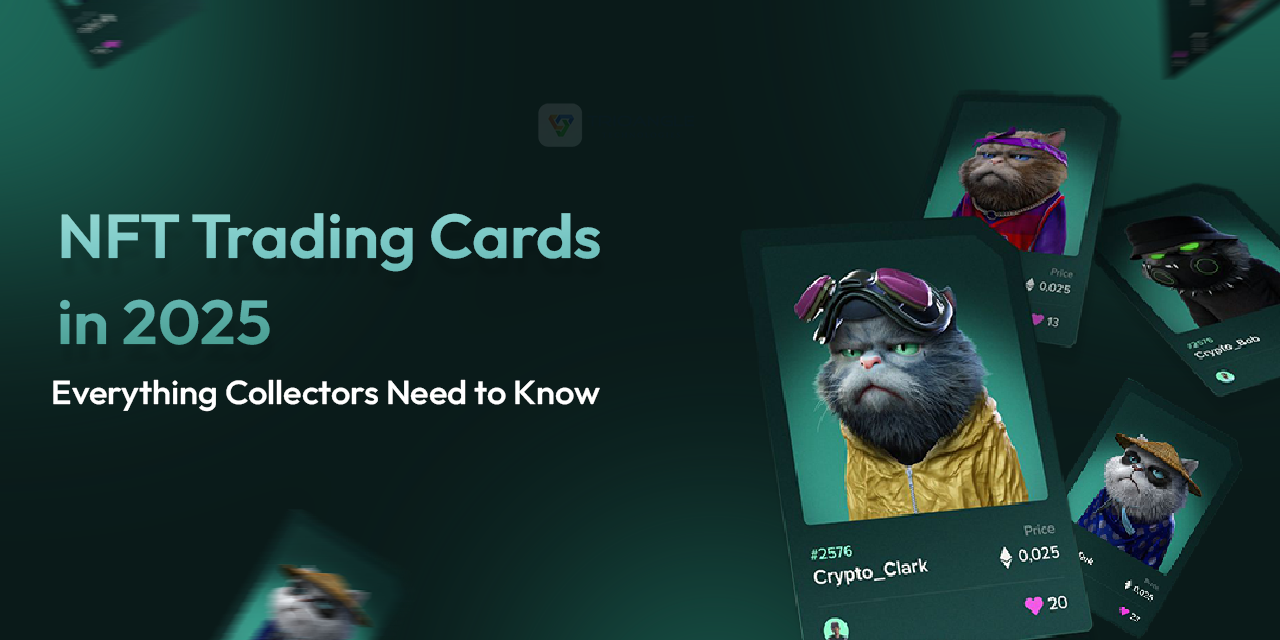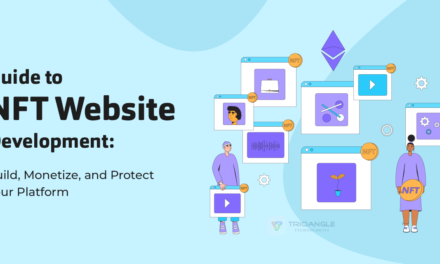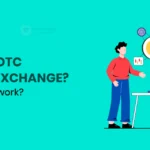Collecting trading cards was once centered around shoeboxes, plastic sleeves, and old comic stores. Today? It’s a blockchain-driven experience where creativity, ownership, and value intersect instantaneously. Collecting NFT trading cards has become more than just a digital pastime. It’s a gateway to community building, brand engagement, and Web3 innovation.
From lively 3D elements to functional game cards… NFT collectibles are transforming into programmable assets that have genuine market depth. And behind the scenes? Smart entrepreneurs are building custom ecosystems to support this growth. With the rise of NFT marketplace development, creators and startups now have full control… over how digital cards are minted, traded, and monetized.
This blog dives deep into the world of collecting NFT trading cards… not just how they work, but why they’re becoming a serious business model for forward-thinking founders… and collectors shaping the next generation of value exchange.
What Are NFT Trading Cards?
NFT trading cards represent the digital advancement of traditional collectibles. Meant to replicate the uniqueness and nostalgia of traditional cards. And supported by blockchain technology. but with the benefits of technology. Since each card is minted as a non-fungible token (NFT), it is difficult to copy, unique, and traceable.
They’re like Pokémon or baseball cards, but they live in your digital wallet rather than a shoebox below your bed.
These digital assets can be dynamic, interactive… or even playable in NFT trading card games, in contrast with static paper cards. As a result, collectors may now own, trade, and display digital cards… in the same way that they can their physical counterparts.
The only difference is that they are able to prove authenticity and scarcity on-chain.
From DC NFT cards to Trump NFT cards… These collectibles come in many forms: celebrity moments, superhero artworks, or game-enhancing assets in NFT trading card games.
Platforms like HRO NFTs offer hybrid experiences. Where a single card exists both digitally and physically. Bridging two worlds for serious collectors.
What sets this apart is the dynamic utility. Some offer perks like gated community access… while others function as in-game power-ups in 3D environments. The worth is found not solely in scarcity, but in involvement.
Exploring the Different Categories of NFT Trading Cards
NFT trading cards go far beyond flashy collectibles. They’re a growing asset class reshaping fandom, gameplay, and digital ownership across many industries. From superhero drops to in-game utilities… and even pro sports licensing, each category carries its own value logic. For entrepreneurs, collectors, and builders, understanding these categories is essential for market positioning.
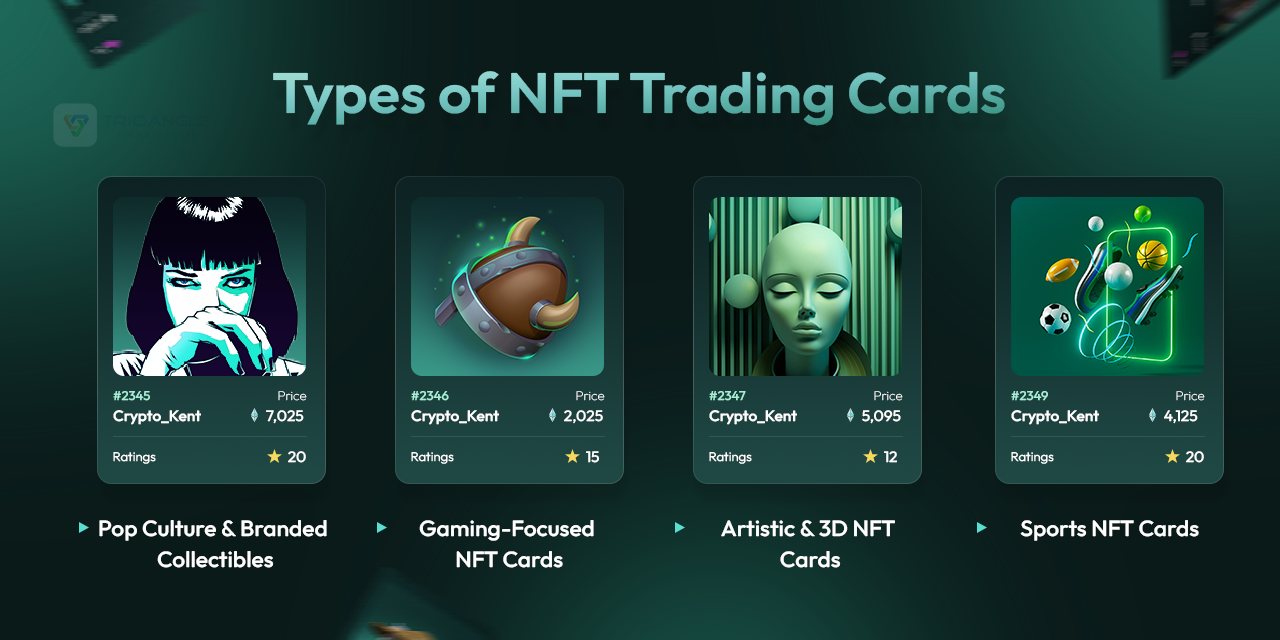
Pop Culture & Branded Collectibles
These include iconic releases… like DC NFT cards, Trump NFT cards, and HRO NFT trading cards. They often feature characters, celebrity moments, or IP-based drops with limited availability. DC hybrid NFT trading cards, for example, offer both physical and digital formats. Tapping into dual-ownership psychology.
Gaming-Focused NFT Cards
In NFT trading card games, these cards aren’t just for show… they’re functional assets. Each card can represent a character, weapon, or skill set with unique game mechanics. This utility gives them intrinsic value, turning gameplay into a tradable economy. Entrepreneurs exploring various top NFT marketplaces consistently and building around this use case.
Artistic & 3D NFT Cards
Visual storytelling comes alive here. through 3D NFT trading cards or hand-drawn, digitally enhanced artworks. These cards appeal to collectors who value originality, scarcity, and creator-backed provenance. Many NFT marketplace development companies now support tools to create these cards with layered designs and programmable traits.
Sports NFT Cards
A rising category that goes beyond fandom. Licensed sports NFT cards bring real-world athletes into Web3. Offering fans a chance to own historic plays, player stats, or limited-edition moments. These aren’t just souvenirs. Some offer fantasy league access, event perks, or resale value via major NFT marketplace platforms.
Physical cards vs. NFT digital trading cards
The conflict between new NFT trading cards and emerging physical cards is about more than format. It’s about the fundamental redefining of experience, value, and ownership. Let’s analyze it according to the main elements… that collectors, business owners, and Web3 builders care about the most.
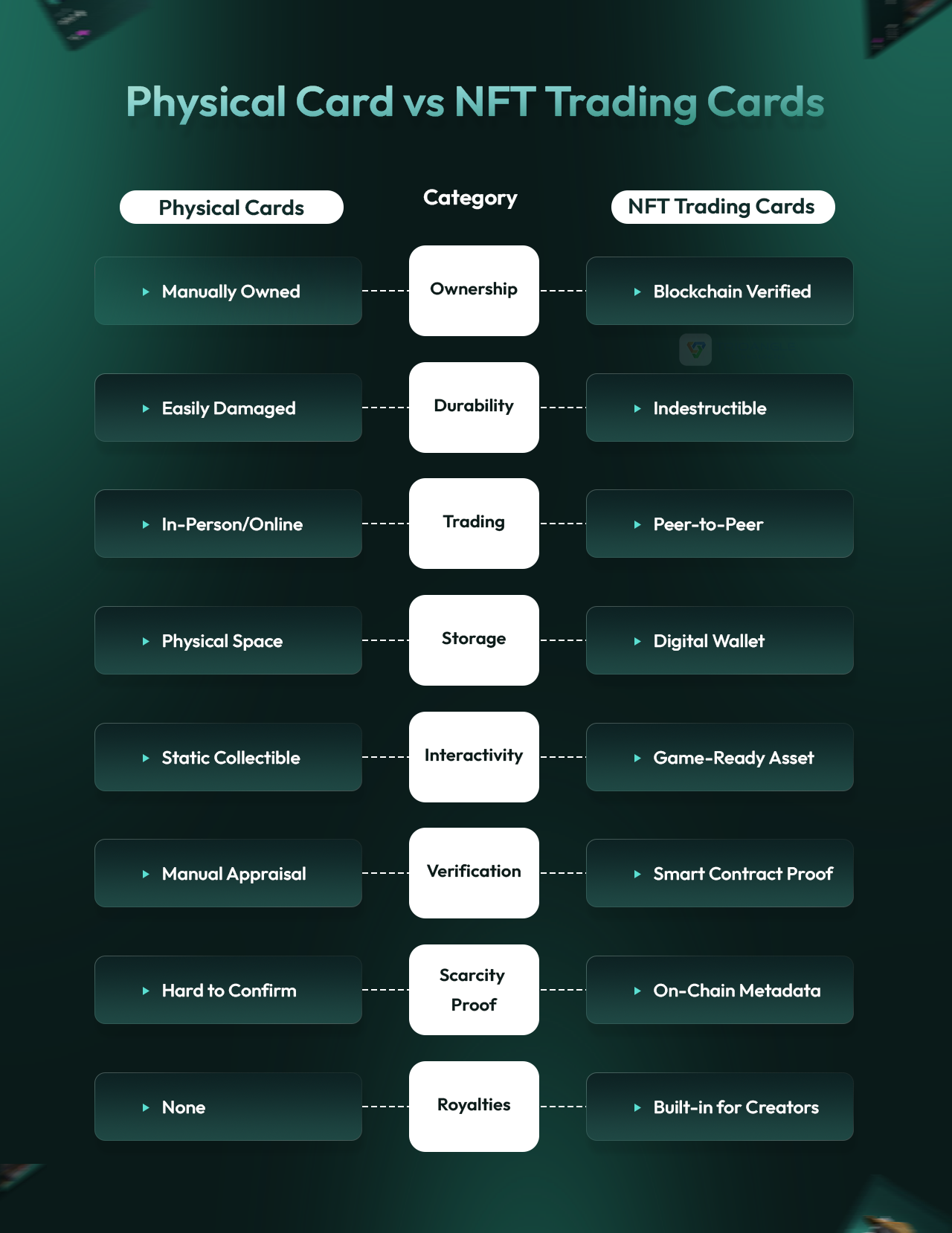
Ownership & Authenticity
- Physical Cards: Ownership depends on physical possession. Authenticity often requires grading services or expert verification.
- NFT Trading Cards: Ownership is cryptographically verifiable. Each card whether a DC NFT card or Trump NFT trading card… has a unique token ID traceable on-chain, eliminating fakes.
Condition & Longevity
- Physical Cards: Vulnerable to wear, moisture, and mishandling. Condition directly impacts market value.
- Digital Cards: Immutable. No creases or fading. Collecting NFT trading cards ensures permanent preservation regardless of time or use.
Accessibility & Trading
- Physical Cards: Limited by geography. Selling requires physical shipment and manual negotiation.
- NFT Cards: Borderless. These cards for sale can be listed, bought, or traded instantly. on any supported NFT marketplace platform from anywhere.
Utility & Interactivity
- Physical Cards: Mostly static. Value lies in nostalgia or rarity, with little real-world utility.
- NFT Cards: Dynamic. Cards in NFT trading card games offer gameplay mechanics. level-ups, or access to events. 3D NFT trading cards add motion and visual engagement.
Storage & Space
- Physical Cards: Need physical storage, protection sleeves, and display cases.
- NFT Cards: Stored in secure digital wallets. Easily accessed or displayed in virtual galleries or NFT marketplace development platforms.
While physical cards carry legacy charm… Collecting NFT trading cards offer innovation, scalability, and real-world use cases. Entrepreneurs exploring NFT marketplace development or planning to create these… aren’t replacing tradition, they’re evolving it. This shift opens doors for hybrid models. like HRO NFTs, combining both worlds into one collectible future.
How to trade NFT cards?
Trading NFT cards is more than clicking buy or sell. It’s a structured process built on blockchain logic and collector intent.
Here’s how it works
Choose a Trading Platform That Fits Your Niche
Every trading journey starts with the right space. Some platforms focus on hero-themed collections, others on sports or game assets. Whether you’re into rare digital drops or interactive card sets… make sure the platform supports the specific type of cards you’re after.
Create and Connect Your Digital Wallet
Think of your wallet as your identity and locker in this ecosystem. Set up a secure wallet (like MetaMask or WalletConnect). then connect it to your chosen marketplace. This allows you to store, send, and receive NFT cards. without relying on third-party permissions.
Fund Your Wallet with Cryptocurrency
To trade, you need currency. Most platforms use tokens like Ethereum or Polygon. Add crypto to your wallet from a trusted exchange… to prepare for purchases or transaction fees.
Discover Cards and Evaluate Details
Not all cards are equal. Browse the collection and check each card’s creator… release date, rarity, and previous ownership. Whether you’re exploring superhero-themed assets or collectibles with in-game value. Understanding what you’re buying is key.
Buy, List, or Propose a Trade
Once you’ve made your pick… or want to offload a card. You can either buy directly, list your card for sale, or negotiate a trade with another user. Some platforms even allow bundle trades or offers, making peer-to-peer exchanges more flexible.
Finalize the Swap via Smart Contract
Once both sides agree, the transaction is carried out automatically. Smart contracts in NFT Marketplace handle the transfer, updating ownership across the blockchain securely. No intermediaries. No confusion.
Manage and Use Your Cards After Trade
After the trade, the card lives in your wallet. You can keep it, use it in supported games, resell it later, or simply showcase it as part of your collection.
This isn’t just digital flipping. It’s a modern form of asset exchange with transparency at its core. Trading NFT cards blends strategy, timing, and community. A new chapter in the long tradition of collectible culture.
How to Create an NFT Trading Card?
Creating NFT trading cards blends creativity with blockchain logic. It’s not about making digital art. it’s about designing unique, ownable assets. That carry value, rarity, and sometimes even utility.
Whether you’re building a collection inspired by pop culture, like DC NFT cards, or launching your own series for a nft trading card game… the process follows a thoughtful, structured flow.
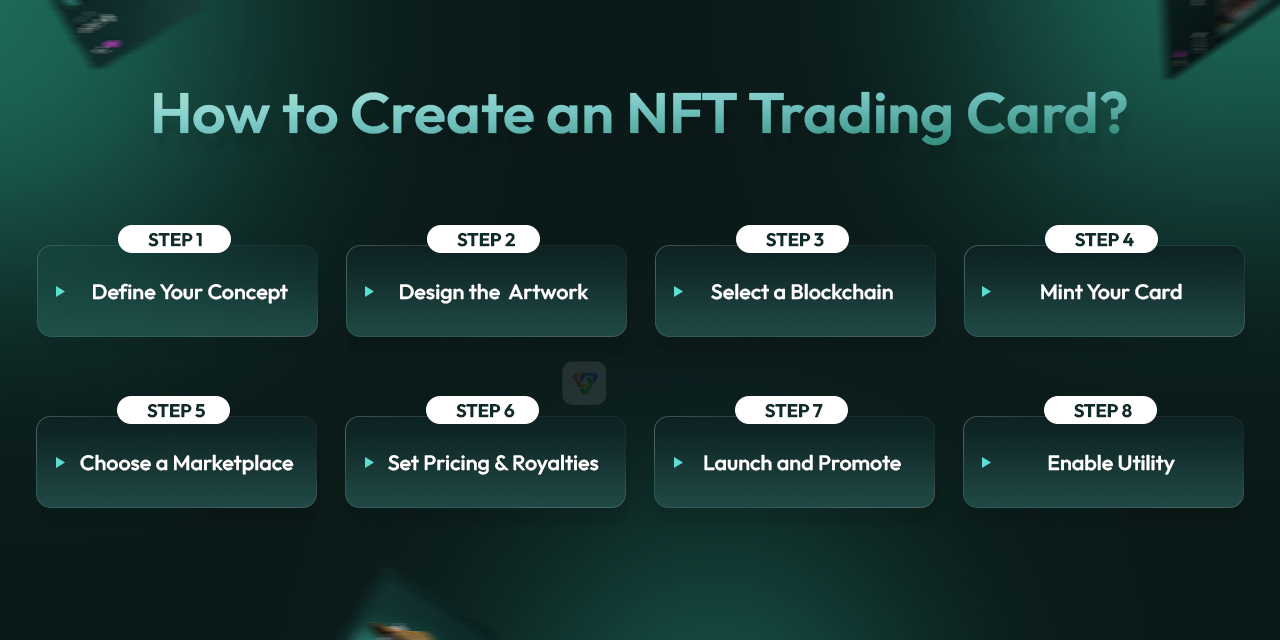
Step 1: Define the Concept and Purpose
Start with clarity. What’s the theme of your cards? Are they game-based, collectible-only, or a hybrid? For example, Trump NFT trading cards revolve around a public figure. HRO NFT trading cards bridge physical and digital ownership. A well-defined concept helps you decide on rarity tiers, visual style, and use-case.
Step 2: Design the Artwork
Each card should have a visually engaging front. maybe adding names, levels, lore, stats, or other information if it’s a gaming feature. If you’re making a 3D NFT trade card, use animations or high-resolution graphics. Unique aesthetics can add serious value. especially for collectors looking to buy NFT trading cards with long-term worth.
Step 3: Mint the Cards on a Blockchain
Choose a blockchain that fits your needs. Ethereum, Polygon, or Flow are popular choices. Minting involves turning your digital card into a token using smart contracts. This step assigns your card a unique identity, making it traceable and secure. If you’re building a custom project, collaborate with an NFT marketplace development company. to integrate tailored smart contract logic.
Step 4: List and Launch
Once minted, your cards can be listed as NFT trading cards for sale on relevant marketplaces. Whether you’re launching a limited drop of DC trading card NFTs. or creating a full set for Collecting NFT trading cards. the launch should include clear details on quantity, perks, and access rules.
Step 5: Enable Future Utility
Add long-term value by connecting your cards to gameplay, loyalty programs, or metaverse perks. This step isn’t essential but can elevate your cards from static assets to dynamic, interactive collectibles. just like those used in evolving NFT trading card games.
How to keep NFT trading cards safe?
Trading NFT cards are more than just a digital image. It’s holding value, history, and sometimes utility. Whether it’s rare DC NFT cards, limited-run HRO NFTs, or animated 3D NFT cards. Protecting them is as crucial as collecting them.
Here’s how to do it right.
Use a Trusted Digital Wallet
The safety of your cards begins with your wallet. Popular non-custodial wallets like MetaMask, Trust Wallet, or Ledger (hardware). give you full control over your assets. Hardware wallets, especially, offer offline protection. Ideal for serious collectors of assets like Trump NFT trading cards or other high-value pieces.
Secure Your Seed Phrase
Your wallet’s recovery phrase is the master key to your NFTs. Write it down on paper, never store it digitally. Avoid sharing it with anyone. If someone gains access to this phrase, they gain full control over your NFTs. Whether it’s DC trading card NFTs or game-based tokens from NFT trading card games.
Beware of Phishing Links and Fake Marketplaces
Scammers often mimic legitimate sites. Prior to accessing any NFT marketplace development platform, always verify URLs. Bookmark official sites, especially if you regularly browse NFT trading cards for sale. Or look at collecting them from community drops.
Avoid Unknown Smart Contracts
Never sign random transactions or approve smart contracts you don’t understand. Some hidden permissions can drain your wallet. For example, if you’ve minted or plan to create them… audit your approvals regularly to prevent accidental asset transfers.
Monitor Asset Activity
Keep track of your collection. You may keep track of all your assets in one location with the use of wallet trackers or NFT portfolio dashboards. Whether you’re collecting NFT trading cards or actively flipping assets… visibility keeps you alert to unauthorized activity.
Digital doesn’t mean invincible. Securing your NFT dc trading cards or collections from a NFT marketplace development company… requires digital literacy and regular vigilance.
The good news? With a few smart steps, your collection remains safe, scalable, and truly yours.
Business Benefits Of NFT Trading Card
New Revenue Models
Launching a collection of NFT trading cards for sale allows creators, brands, and publishers… to generate revenue from digital assets without middlemen. From DC NFT cards to Trump NFT trading cards… direct minting and resale fees create long-tail earnings even after the initial drop.
Secondary Market Royalties
Each time a digital card is resold… Smart contracts can automatically route a percentage of the sale back to the original creator or business. This is a key advantage over physical cards, which offer no post-sale profit. Projects like HRO NFTs capitalize on this by integrating royalties into their contract logic.
Gamified Engagement
NFTs aren’t static. With nft trading card games, cards can unlock gameplay, rewards, or exclusive experiences. Businesses building around collecting NFT trading cards can retain users through evolving mechanics… rarity ladders, or virtual battles that deepen user investment.
Brand Loyalty and IP Monetization
Franchises can repurpose existing content through NFTs. For example, dc hybrid nft trading cards allow IP owners to transform static comic artwork into dynamic assets. turning fans into collectors, and collectors into community investors.
Interoperability & Platform Independence
Through custom nft marketplace development… businesses can launch independent platforms that host, sell, and trade cards directly. Unlike closed ecosystems, a brand-owned nft marketplace development company can control the customer journey… end-to-end—offering flexibility across chains and formats.
Closing Thoughts
The art of collecting NFT trading cards is redefining digital ownership. No longer a niche hobby but a powerful model for community, commerce, and culture. These aren’t just collectibles. They’re programmable assets that move, evolve, and unlock new value in real time.
And behind every great digital collectible ecosystem is a platform built with intention. That’s where vision meets execution. Trioangle, known for its sharp grasp on scalable tech, stands out in the space of NFT marketplace development. Not just building marketplaces, but engineering experiences… Where creators and collectors can thrive on their own terms.
For founders and developers building in this space, the opportunity is wide open. And for collectors? The chase just got smarter, faster, and more rewarding. The real win lies not just in owning a rare card… but in owning your place in the future of decentralized collecting.

